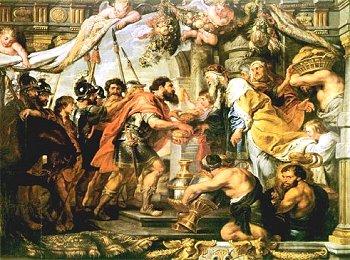 |
|
The Meeting of Abraham and Melchizedek.
by Peter Paul Rubens, Flemish 1577-1640.
SN 212 Oil on Canvas c.1625
By Robert Anderson. 2000
Artist:
Peter Paul Rubens, along with the Italian sculptor Gianlorenzo Bernini, was one of the
greatest artists of the 17th century. His canvases can be said to define the scope and
style of high baroque painting through their energy, earthy humanity and inventiveness. A
devoutly religious man, a man of learning and a connoisseur of art and antiquities, he was
also a man of the world who succeeded not only as an artist but as a respected diplomat in
the service of Isabella and Albrecht of the Spanish Netherlands. |
Travels to Venice where he studied Titian, Veronese & Tintoretto freed
his artistic talent from rigid classicism. While he did incorporate copies of classical
statues in his paintings he always avoided the appearance and coldness of stone. To the
contrary, his nudes, for which he became famous, always depicted an ample female form of
vitality and good health as well as of sensuousness. His mastery of color along with his
knowledge of antiquity is seen particularly in his mythological paintings.
As court painter and confidant to the Archduchess Isabella Clara Eugenia,
Rubens recognized the role art was to play in the Counter Reformation. His genius found
expression in his designs for the Triumph of the Eucharist tapestries which he and his
assistants completed between 1625 and 1628.
Knighted by two monarchs and master of a successful workshop, Rubens
became rich and famous in his own time. Having executed over 3,000 paintings, woodcuts and
engravings of all types, he died the most respected artist of his time in 1640.
Subject:
The Book of Genesis in the Old Testament recounts the story of the patriarch Abraham
meeting with the king and priest Melchizedek. In a battle between some kings of the day,
Abraham's nephew Lot had been captured by the victors and taken away captive. When Abraham
heard what had happened he raised an army, pursued the captors of Lot and rescued him
along with rich treasure. Upon returning home Abraham was welcomed by the Melchizedek who
blessed him and gave bread and wine to the victorious army. Abraham in return gave a gift
of a tithe (10%) of his booty to Melchizedek. This was seen as recognition of
Melchizedek's position as a priest of the God of Israel.
Painting:
This painting of oil on canvas is done in reverse, as it was to be used by tapestry makers
who weave from the back of the piece on which they are working. It is the largest and most
complex of the cartoons. In the painting we see the central figures of Abraham and
Melchizedek balanced by Abraham's soldiers on the left and the sevants of Melchizedek on
the right. The whole painting is framed between columns and is dipicted on a tapestry held
aloft by three putti or cherubs. A garland of fruit hangs from the top edge from which
bunches of grapes hang over Abraham's head in reference to the wine / blood of Christ in
the New Testament Eucharist. Large golden vases of wine are shown being brought from below
right and one muscular bearer glares out at us - a common baroque device to engage the
viewer. The priest, Melchizedek, stands a bit above Abraham, much as a Christian priest
might do when serving Mass. Abraham reaches for the bread as would a member of a Christian
congregation receiving the bread of the Eucharist. Young boys pass out bread to the
soldiers suggesting the function of acolytes distributing the wafer during the Mass.
This painting is the most dynamic of the Eucharistic tapestries with the
surging figures approaching the center of the composition thereby dramatically focusing on
the two protagonists. Bodies and hands reach toward one another symbolizing the mystical
unity between the Old and New Testaments.
Historical Context:
The cycle of eleven paintings of The Triumph of the Eucharist was commissioned by the
Archduchess Isabella who was the daughter of Philip II of Spain and the Governor of the
Spanish Netherlands. It was planned as a gift for the convent of the Descalzas Reales in
Madrid in 1625 where it still hangs today. This Franciscan Order of Poor Clares was one
with which Isabella was closely associated.
The series is a mixture of allegory and religious propaganda intended to
promote the worship of the Eucharist (ie the bread and wine consecrated as the body and
blood of Christ and distributed at communion) which had been strengthened recently by the
Council of Trent and which constituted an important element in Counter Reformation
Catholicism.
This was a time of great concern on the part of the Catholic church as it
attempted to correct not only the abuses of the clergy but also to reaffirm its tenets /
dogma in the face of attacks by the Protestant Reformation.
ringlingdocents.org
|
